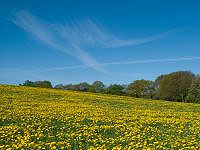Walking On Christ’s Property

Nestled in the midst of busy, crowded streets lined with shops in upper Manhattan is a place of quiet and beauty called The Cloisters. On the high bluffs overlooking the Hudson River, this extension of the Metropolitan Museum of Art includes a collection of religious architectural art and tapestries of medieval Europe in a lovely monastery-like building set in an expansive park. I’m not certain which we enjoyed more: the exquisite art inside or the well-kept gardens, winding trails, and benches in the sprawling woods outside. Both refreshed our souls.
“The whole earth,” Christopher Wright notes, “belongs to Jesus. It belongs to him by right of creation, by right of redemption and by right of future inheritance—as Paul affirms in the magnificent cosmic declaration of Colossians 1:15-20. So wherever we go in his name, we are walking on his property. There is not an inch of the planet that does not belong to Christ.” We are walking on his property—a fine phrase.
Though most of the art housed in The Cloisters in religious, the Met is a secular institution. I know nothing of its curators or directors, but appreciate their efforts to preserve and share beauty. There is something special in the fact that the quiet seclusion and creativity of The Cloisters is set within the bustle and commerce of Manhattan. It’s like a gentle oasis, a place to rest and know that there is more to life than buying, selling, and working.
A few days later we drove through New Bedford, the city of my birth, past vast empty factories, rusting from disuse. Further on deep scars were cut through wooded land for yet one more mall along a highway lined with them, some empty and decaying. The wind picked up, bringing both the lovely salt-water scent of the ocean and an assortment of plastic bags and grubby newspaper.
Caring for the earth has become politicized, an issue to be hotly debated, conservative v. liberal. In such a setting the first responsibility we have as Christians is to refuse to be drawn in. There is nothing to debate—we are walking on Christ’s property. We are tenants; he is landlord. His creation reflects his glory, as does the creation of human artists made in his image. Just as I would not deface the centuries old tapestries hanging in The Cloisters, so I must not deface his world. And just as I would want to preserve and tenderly care for those tapestries, so I must act always to preserve and tenderly care for my King’s creation. Isn’t that what tenants do, especially if they love their landlord?
It’s finally a matter of worship.

